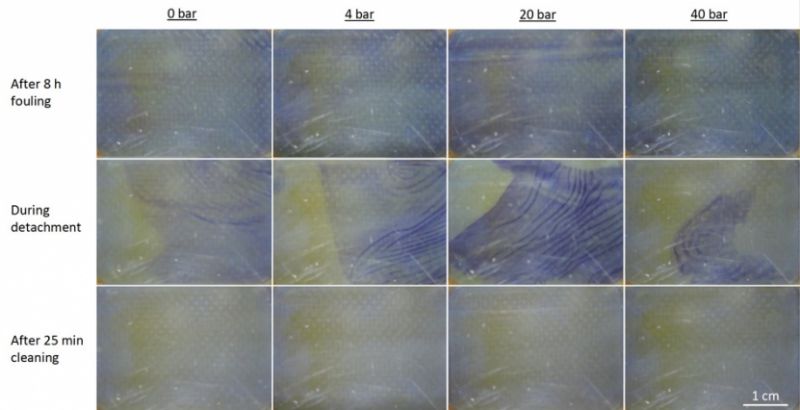Toward Efficient High-pressure Desalination
Published on by Water Network Research, Official research team of The Water Network in Academic
Surprisingly, pressurization isn’t to blame for fouling of membranes, study finds.
By David L. Chandler | MIT News Office

Images obtained in their laboratory setup enabled Emily Tow and Professor John Lienhard to show exactly how biofouling material builds up on a membrane over time, and how it is removed under different pressure conditions. Image source: MIT - Courtesy of the researchers
The desalination industry, a critical source of potable water in many arid regions, generated more than $13 billion last year and is expected to double within a decade. Most desalination plants today use a process called reverse osmosis (RO), which forces water through huge rolls of membranes, leaving the salt behind. One of the most expensive operational challenges for such plants is the fouling of these membranes by microorganisms.
Now, research from MIT suggests a different approach to reducing the rate of fouling and thus improving the efficiency of RO plants.
The prevailing idea in the industry has been that the high pressure required by RO is responsible for the relatively high rate of fouling, compared to other systems such as forward osmosis. But the MIT study shows that this is not the case, a finding that opens up new approaches to reducing fouling in RO. The research, by Emily Tow ’12, SM ’14, PhD ’17 and MIT Professor John H. Lienhard V, was recently published in the Journal of Membrane Scienceand presented at the 2017 AMTA/AWWA Membrane Technology Conference, where it received the Student Best Paper Award.
Many experts believe that the high pressure in an RO system compresses the microbial mats that grow on the membranes, and that this “compaction” makes the growth much harder to remove. In contrast, in low-pressure forward osmosis (FO) systems, which are less energy-efficient but more fouling-resistant, the supposedly looser mat is thought to be easier to clean off.
However, these microbial mats are generally full of water, which does not compress under RO pressures, so “there is no good reason why high pressure should worsen fouling,” Tow says. She compares the microbes to a scuba diver: “There’s a lot of pressure at the bottom of the ocean, but it doesn’t make you stick to the seafloor.” But if pressure doesn’t matter, and the flow rates through FO and RO systems are similar, what could account for the disparity in fouling resistance?
Watch a ' Cleaning FO membrane at high pressure (20 bar)' video by Emily Tow
Tow, who is now an ITRI-Rosenfeld Postdoctoral Fellow at the Lawrence Berkeley National Laboratory and will be a professor of mechanical engineering at Olin College next year, devised a new approach to isolating the effects of pressure from those of other differences between FO and RO. Her method involves operating an FO system, which uses osmosis to pull water through membranes, at a range of pressures up to 40 atmospheres.
“We measured fouling rates and cleaning outcomes, and even recorded video of the membranes being cleaned at various pressures, and we found no effect of pressure,” she says. Many highly cited papers claimed that pressure was the issue, but previous experiments also varied the concentration of the solution on the back side of the membrane when varying pressure. By raising the pressure on both sides of an FO system without changing anything else, the MIT study revealed that pressure alone does not exacerbate fouling or impede cleaning.
Now that high pressure — which is essential for RO to work — is shown not to affect fouling, researchers should look for other reasons that processes like FO are more fouling-resistant and see if they can be applied to RO, Tow says.
“The observation that forward osmosis membranes are easier to clean is fairly robust,” says Lienhard, who is the Abdul Latif Jameel Professor of Water and Food and director of the Center for Clean Water and Clean Energy and of the Abdul Latif Jameel World Water and Food Security Lab. But the new study shows that FO’s fouling resistance “is not intrinsic to its low pressure. The difference must be related to other factors that could potentially be transferrable to RO. It needs to be understood,” he says.
“The hope is that with further work, this could make it easier to clean RO membranes,” he says. Currently, mitigating membrane fouling is a major part of non-energy operating expenses of an RO plant, which account for about a quarter of the cost of desalinated water. Any improvement in fouling resistance could significantly impact water cost.
Read full article: MIT
Media
Taxonomy
- Treatment
- Reverse Osmosis
- Desalination
- Reverse Osmosis
- Energy Efficiency
- RO & MSF Fouling
- Sustainable Desalination
- Desalination